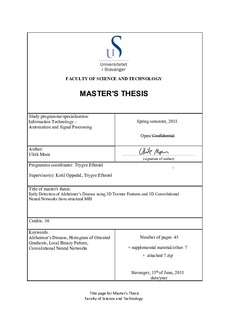| dc.contributor.advisor | Oppedal, Ketil | |
| dc.contributor.advisor | Eftestøl, Trygve | |
| dc.contributor.author | Moen, Ulrik | |
| dc.date.accessioned | 2018-09-26T13:57:36Z | |
| dc.date.available | 2018-09-26T13:57:36Z | |
| dc.date.issued | 2018-06 | |
| dc.identifier.uri | http://hdl.handle.net/11250/2564781 | |
| dc.description | Master's thesis in Automation and signal processing | nb_NO |
| dc.description.abstract | In 2016 there was estimated that around 47 million people in the world were living with dementia, and this number were projected to increase to 131 million by 2050. Alzheimer’s disease is the most common type of dementia and the cost associated with dementia was in 2016 estimated to be around 818 billion US$ world wide. Although there does not exist any treatment that cures or significantly delay the progress of Alzheimer’s disease at this time, early detection is important. It enables people with dementia and their families to be better prepared for the progression of the disease and helps with understanding the disease and its progression, which may speed up the development of a future treatment. Several different biomarkers are being explored in order to give a more reliable and earlier diagnosis. The use of Magnetic resonance imaging of the brain together with machine learning have shown promising results in discriminate between different kinds of dementia and normal controls. In this thesis it was investigated if early diagnosis of Alzheiemr’s disease could be reliably identified using magnetic resonance imaging of the brain together with either three dimensional texture features and random forest or three dimensional convolutional neural networks. The data set used consisted of 2688 MRI scans from 811 subjects, and was obtained from the Alzheimer’s Disease Neuroimaging Initiative. The best accurucy results of the four-class early differential diagnosis problem was 41.1% and for the two-class problem discriminating between subjects with mild cognitive impairment who converted to Alzheimer’s disease or not, was only 60.3%. | nb_NO |
| dc.language.iso | eng | nb_NO |
| dc.publisher | University of Stavanger, Norway | nb_NO |
| dc.relation.ispartofseries | Masteroppgave/UIS-TN-IDE/2018; | |
| dc.rights | Navngivelse 4.0 Internasjonal | * |
| dc.rights.uri | http://creativecommons.org/licenses/by/4.0/deed.no | * |
| dc.subject | informasjonsteknologi | nb_NO |
| dc.subject | signalbehandling | nb_NO |
| dc.subject | histogram of oriented gradients | nb_NO |
| dc.subject | local binary pattern | nb_NO |
| dc.subject | convolutional neural networks | nb_NO |
| dc.subject | Alzheimer's disease | nb_NO |
| dc.subject | demens | nb_NO |
| dc.title | Early Detection of Alzheimer’s Disease using 3D Texture Features and 3D Convolutional Neural Networks from structural MRI | nb_NO |
| dc.type | Master thesis | nb_NO |
| dc.subject.nsi | VDP::Teknologi: 500::Informasjons- og kommunikasjonsteknologi: 550 | nb_NO |

